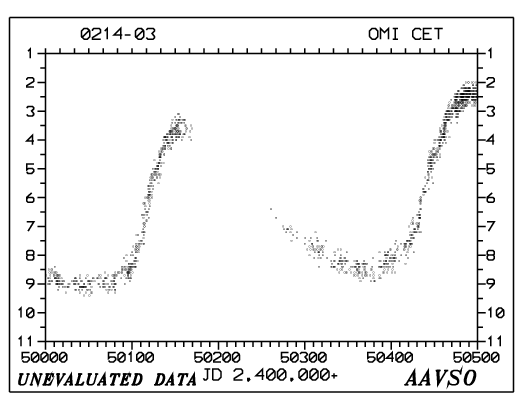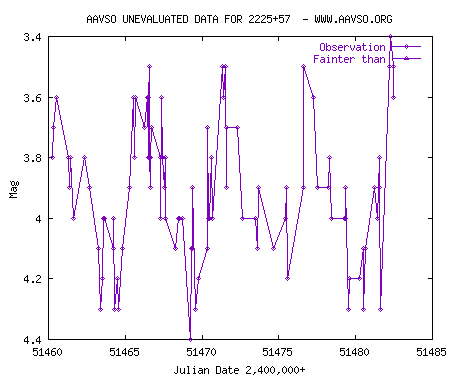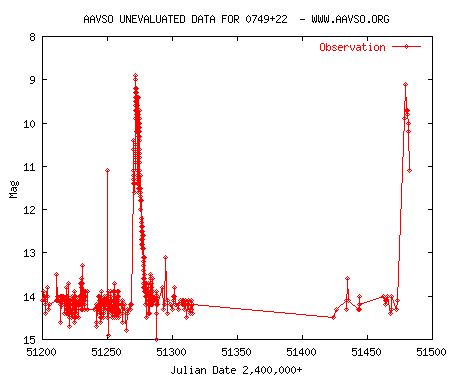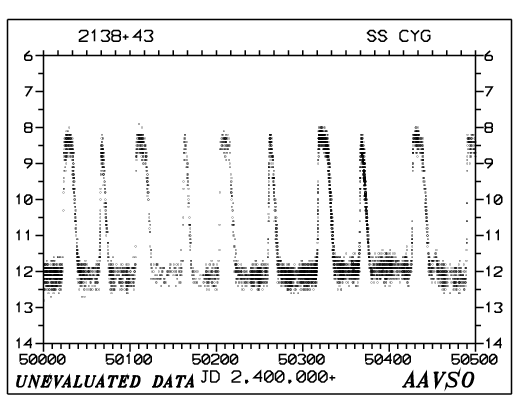Observing Variable Stars
 The study of the heavens, at some point, brings one to the realization that the
sky is not constant. The moon crosses the sky in its monthly pilgrimage, changing
its appearence daily. Comets appear, brighten and fade away. Meteors zip across
the sky to the delight of most. Less obvious change occurs in the stars themselves.
Stars with different characteristics behave differently. Some are quite stable,
burning their fuel at a liesurely pace throughout the eons. Some race through their
fuel with reckless abandon, eventually expiring in supernova explosions. But there
are numerous stars that fall somewhere in between. Depending on their composition, mass
and if they have a partner or not, they may swell and shrink, steal mass from their
companion or behave erratically. These are called "Variable Stars", and they are quite a lot of
fun to observe on a regular basis. On this page and the pages that follow, I hope to give
an understanding of how these different types of variations take place, how you can get
involved in the documentation of their behavior.
The study of the heavens, at some point, brings one to the realization that the
sky is not constant. The moon crosses the sky in its monthly pilgrimage, changing
its appearence daily. Comets appear, brighten and fade away. Meteors zip across
the sky to the delight of most. Less obvious change occurs in the stars themselves.
Stars with different characteristics behave differently. Some are quite stable,
burning their fuel at a liesurely pace throughout the eons. Some race through their
fuel with reckless abandon, eventually expiring in supernova explosions. But there
are numerous stars that fall somewhere in between. Depending on their composition, mass
and if they have a partner or not, they may swell and shrink, steal mass from their
companion or behave erratically. These are called "Variable Stars", and they are quite a lot of
fun to observe on a regular basis. On this page and the pages that follow, I hope to give
an understanding of how these different types of variations take place, how you can get
involved in the documentation of their behavior.
Basic Types of Variable Stars
"Cepheid" Variables (Delta Cephei)
You've probably heard alot about these type of variables. They're often mentioned along with the distance estimates of galaxies. The reason is, they vary in a very predictable way. Their variation is directly proportional to their mass in both intensity and period. You measure how bright the star appears to get and how long it takes it to complete one cycle and you can calculate its absolute magnitude and then its distance, to within a very small error factor. They are very massive stars, typically more than 3 solar masses. They swell and shrink in size as they vary. When they contract, they burn more intensely and "light up" the outer layers, making them appear brighter. Delta Cephei completes a cycle in 5.36 days, varying by just under 1 magnitude. Others Cepheid stars vary much faster. RR Lyrae, for example, completes a cycle in 0.6 days while others of this sub class can vary in under an hour.Long Period Variables (Mira)
Mira type stars are called long period variables because Mira takes a long time to complete one cycle of variation, but there are many more complex examples. These stars that are usually slightly more massive than our own sun, but much larger and therefore less dense. They actually swell and shrink as they burn fuel, like the Cepheids, but when they swell, low densitycarbon is brought to the surface, thus dimming their appearence. The neat thing about Miras is their wide rangingcharacteristics. There are so many subclasses it's hard to keep up! Some stop brightening for a while before reaching maximum, (R Leonis), others pause on the way down. Some have wide ranges and change quickly, (Chi Cygni), and vice versa. Mira itself changes by as much as 6 magnitudes, while other sub classes vary much less. The Miras include a sublass called, "semiregular" that changes character from one cycle to the next.Eruptive Stars (U Geminorum)
Also called "Cataclysmic Variables" or "CV's", these are stars that have a companion. In general, one star is larger and less dense, what's called an M class giant, and one star that's denser and hotter. A dense white dwarf, a neutron star or even a black hole. The denser star pulls matter from the larger star where it collects most often in a disk around the star. When it reaches a certain amount and/or temperature, it triggers a thermonuclear explosion. As you may know, these are very bright. :-) So, the stars overall magnitude rises dramatically, in a short amount of time. Now, the variability that we see most often comes from the changes in the disk, rather than the stars involved. The characteristics of the variation can tell us a lot aout what's happening there. For instance, if the system brightens quickly and fades slowly, perhaps preceded by a burst of x-rays, we can tell that disk suddenly heated from the outside, (toward the M giant), to the inside. If several brightenings are seen, called "humps", before it stabilizes, we can tell that the brightening started on the inside of the disk and moved outward.There are almost as many mechanisms for CV's as there are CV stars. Sometimes, they combine with eclipsers so we can learn even more about them!
Eclipsing Binaries (Algol)
These are also 2 star systems, but usually neither star varies in brightness by itself. It needs the other star to make it look like it changes. The 2 stars are orbiting each other, and it just so happens their orbital plane is in our line of sight. Therefore, every so often, one of them passes in front of the other from our perspective and blocks the light from the other star. The system as a whole drops in magnitude by the amount of the "eclipsed" star. If one star is intrinsically brighter than the other to begin with, we can then tell which one is being blocked by measuring how much the system dims. This is kinda neat!Light Curves
In studying variable stars, it's important to keep good records to keep track of the brightness changes. Plotting the estimates you and others make creates a "light curve" chart of the star's brightness over time. What follows are a few examples of the general types we've discussed, complete with captions.
Some links to international VSO organizations.
| AAVSO: The American Association of Variable Star Observers, of which I am a member. | British VSO: How they see stars from there, I'll never know. | Czech VSO or here.: Strong group of dedicated people. | VSNET: Variable Star mailing list archive. | Japanese VSO: Why not? They do most everything else well...Besides, the site shows a lot of enthusiasm. |




 Page URL: http://www.stonehavenobservatory.com/AAVSO.html
Page URL: http://www.stonehavenobservatory.com/AAVSO.html